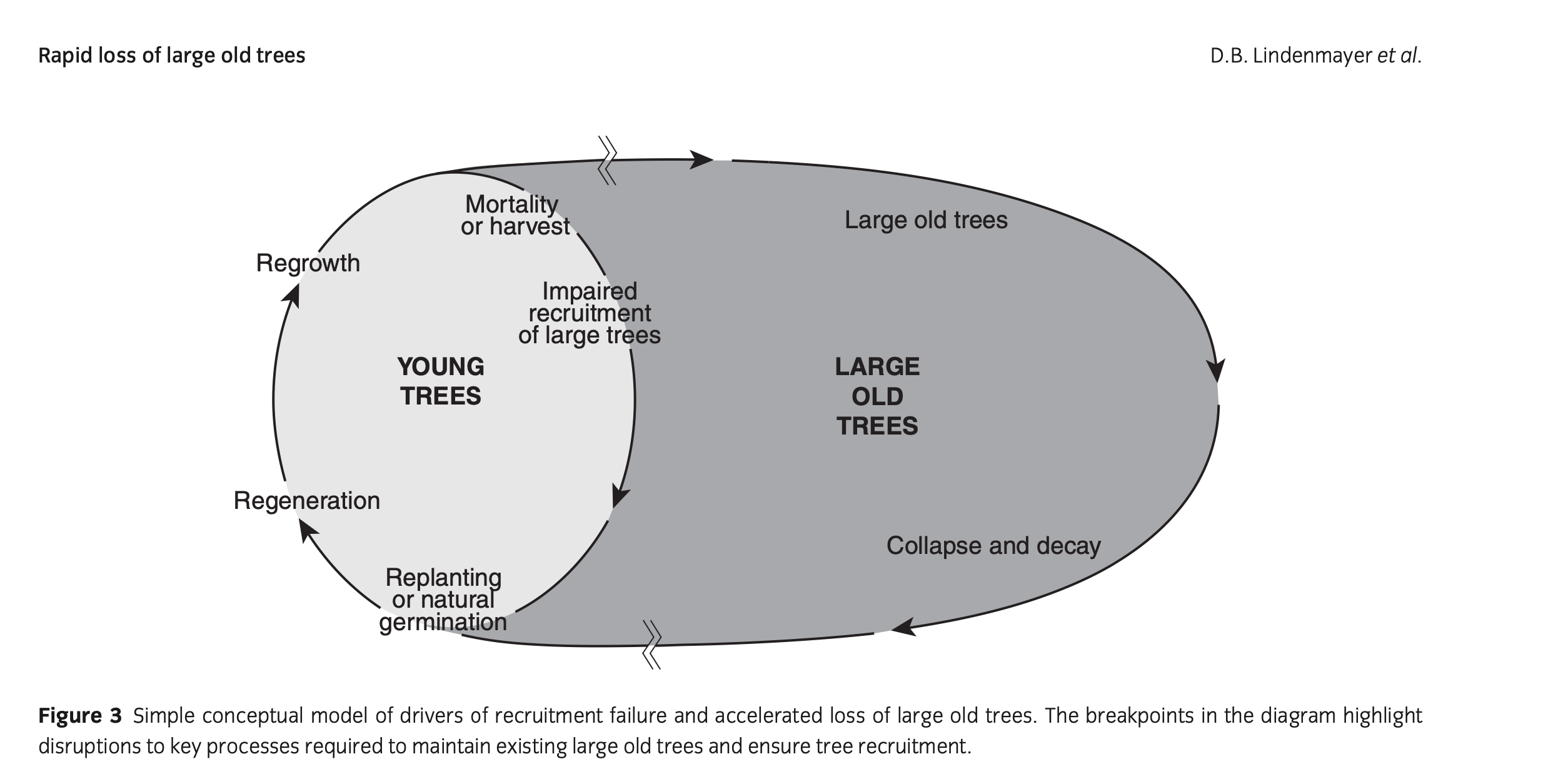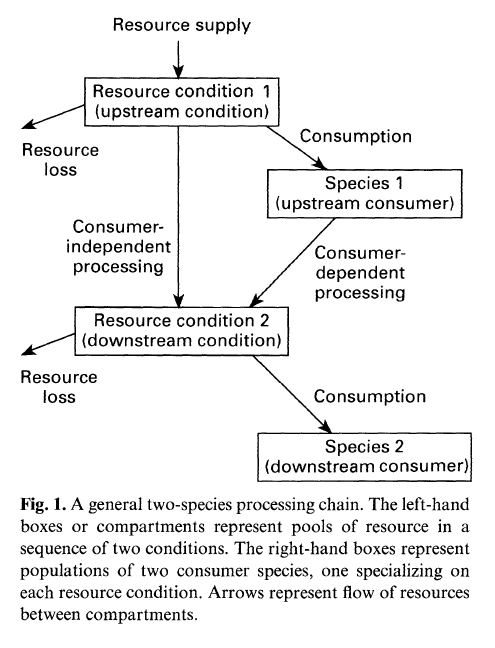Supply
This note is about the concept of supply, especially heterogenous or multi-modal supply of habitat structures by biological and artificial systems.
In Ecology
Cf.
-Niche]

Lindenmayer, David B., William F. Laurance, Jerry F. Franklin, Gene E. Likens, Sam C. Banks, Wade Blanchard, Philip Gibbons, et al. “New Policies for Old Trees: Averting a Global Crisis in a Keystone Ecological Structure.” Conservation Letters 7, no. 1 (2013): 61–69. https://doi.org/10/f22gtb.
Definition
Supply of habitat is a function or a service provided by some members of an ecosystem to other members.
This word is useful because it emphasises the active provisioning of a resource and links different modes of provisioning.
Related terms:
- provision of ecosystem services (such as habitat provision, biologically generated habitat provision)
- improvement of habitat quality
- habitat availability (sounds passive by contrast)
- ecological services (ES) supply maps
- resource supply (e.g., cf. supply/demand in population ecology) 1
- resource use efficiency 2
- processing chain ecology 3

Pamela R. Dykstra, ‘Thresholds in Habitat Supply: A Review of the Literature’, Wildlife Report (Victoria, British Columbia: Ministry of Sustainable Resource Management, 2004).
In Ecosystem Services
Need to define an attitude towards economic approaches to 'nature management'.
Benjamin Burkhard et al., ‘Mapping Ecosystem Service Supply, Demand and Budgets’, Ecological Indicators, Challenges of sustaining natural capital and ecosystem services, 21 (2012): 17–29, https://doi.org/10/dtf2wq.
Wenbo Cai et al., ‘Assessing Ecosystem Services Supply-Demand (Mis)Matches for Differential City Management in the Yangtze River Delta Urban Agglomeration’, International Journal of Environmental Research and Public Health 18, no. 15 (2021): 8130, https://doi.org/10/gr2hzg.
María José Martínez-Harms and Patricia Balvanera, ‘Methods for Mapping Ecosystem Service Supply: A Review’, International Journal of Biodiversity Science, Ecosystem Services & Management 8, no. 1–2 (2012): 17–25, https://doi.org/10/ggrngm.
Vera Rullens et al., ‘Who Is Contributing Where? Predicting Ecosystem Service Multifunctionality for Shellfish Species Through Ecological Principles’, Science of The Total Environment 808 (20 February 2022): 152147, https://doi.org/10/gqppc4.
Marino, Davide, Margherita Palmieri, Angelo Marucci, and Massimo Tufano. ‘Comparison between Demand and Supply of Some Ecosystem Services in National Parks: A Spatial Analysis Conducted Using Italian Case Studies’. Conservation 1, no. 1 (2021): 36–57. https://doi.org/10/gk75mv.
References
Walt Klenner and Russ Walton, ‘Landscape-Level Habitat Supply Modelling to Develop and Evaluate Management Practices That Maintain Diverse Forest Values in a Dry Forest Ecosystem in Southern British Columbia’, Forest Ecology and Management 258 (2009): S146–57, https://doi.org/10/bvh9wv.
Eckehard G. Brockerhoff et al., ‘Forest Biodiversity, Ecosystem Functioning and the Provision of Ecosystem Services’, Biodiversity and Conservation 26, no. 13 (2017): 3005–35, https://doi.org/10/gck8th.
Peter A. Vesk et al., ‘Time Lags in Provision of Habitat Resources Through Revegetation’, Biological Conservation 141, no. 1 (2008): 174–86, https://doi.org/10/b6z2s8.
Elizabeth Elliot Noe et al., ‘Habitat Provision Is a Major Driver of Native Bird Communities in Restored Urban Forests’, Journal of Animal Ecology 91, no. 7 (2022): 1444–57, https://doi.org/10/gr2hxn.
Craig R. Nitschke et al., ‘Spatial and Temporal Dynamics of Habitat Availability and Stability for a Critically Endangered Arboreal Marsupial: Implications for Conservation Planning in a Fire-Prone Landscape’, Landscape Ecology 35, no. 7 (2020): 1553–70, https://doi.org/10/gqsd38.
Several chapters here refer to relevant dynamics:
Patrick J. Baker, David R. Larsen, and Alark Saxena, eds., Forests as Complex Social and Ecological Systems: A Festschrift for Chadwick D. Oliver (Cham: Springer, 2022).
In Industrial Systems and Economics
Relevant terms:
- supply chain
The amount of a good or a service available to consumers. Or the quantity of a commodity that a supplier is able and willing to sell.
Nazli Turken et al., ‘Nature Inspired Supply Chain Solutions: Definitions, Analogies, and Future Research Directions’, International Journal of Production Research 58, no. 15 (2020): 4689–4715, https://doi.org/10/gpr62t.
Examples
- Supply of perch branches, cf. Perches
- Supply of hollows ("when the harvest rotation time is 100 years or less, a supply of trees with hollows cannot be ensured by only retaining trees which already have hollows")
Ball, Ian R., David B. Lindenmayer, and Hugh P. Possingham. ‘A Tree Hollow Dynamics Simulation Model’. Forest Ecology and Management 123, no. 2–3 (1999): 179–94. https://doi.org/10/dfnm5g.
"the need for recruitment of new hollow-bearing trees to ensure there is a perpetual supply of such resources"
Gibbons, Philip, and Dadid B. Lindenmayer. ‘Issues Associated with the Retention of Hollow-Bearing Trees Within Eucalypt Forests Managed for Wood Production’. Forest Ecology and Management 83, no. 3 (1996): 245–79. https://doi.org/10/d9nrvw.
Footnotes
Gutierrez, Andrew P. Applied Population Ecology: A Supply-Demand Approach. New York: John Wiley & Sons, 1996.˄
Hodapp, Dorothee, Helmut Hillebrand, and Maren Striebel. ‘“Unifying” the Concept of Resource Use Efficiency in Ecology’. Frontiers in Ecology and Evolution 6 (2019): 233. https://doi.org/10/gf64vv.˄
Heard, Stephen B. ‘Processing Chain Ecology: Resource Condition and Interspecific Interactions’. Journal of Animal Ecology 63, no. 2 (1994): 451–64. https://doi.org/10/ftssbr.˄
Backlinks